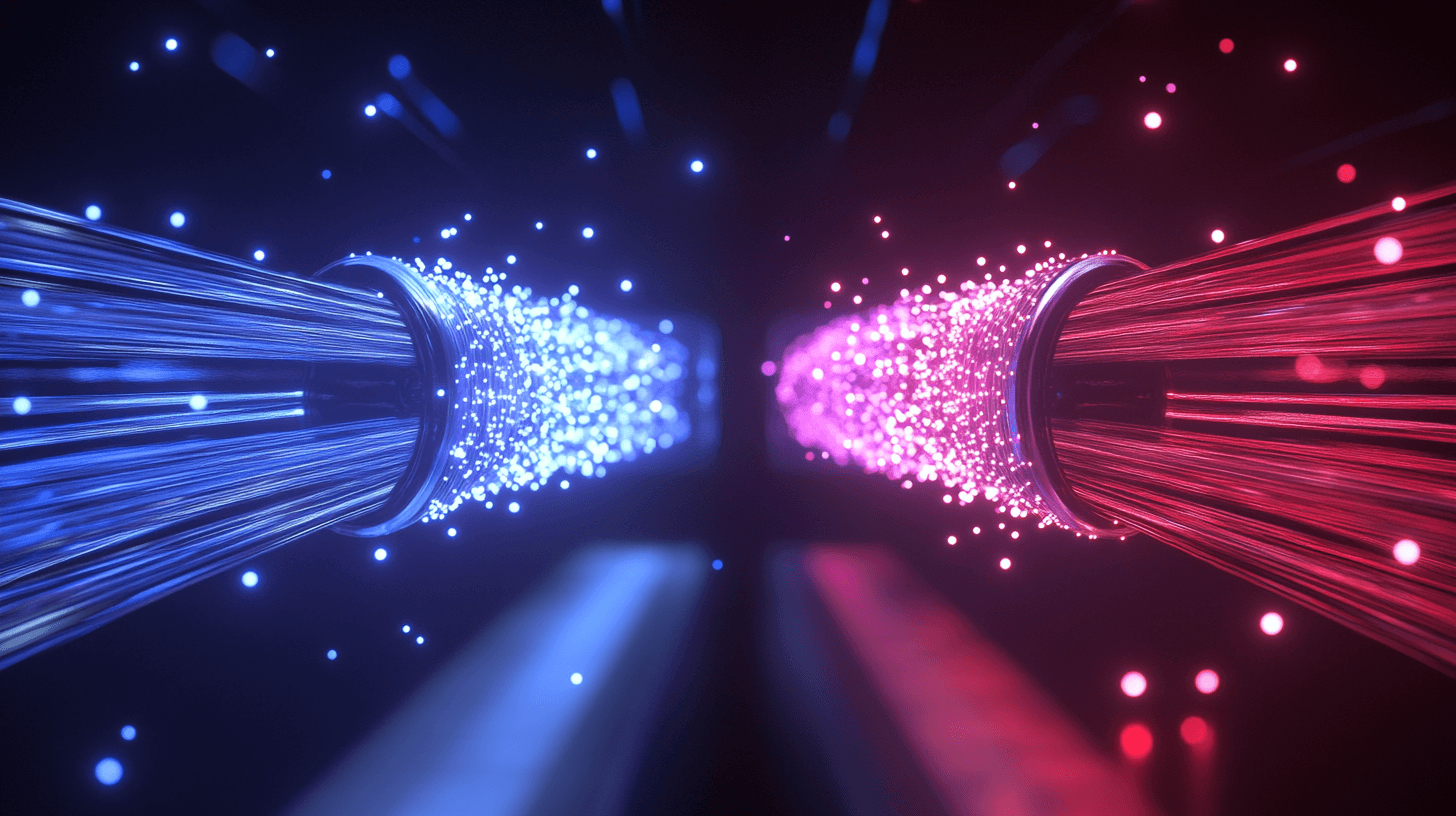
How Fiber Optic Cables Work: The Complete Guide
In today's interconnected world, the need for fast, reliable data transmission has never been greater. Enter fiber optic cables - the unsung heroes of our digital age. These remarkable strands of glass or plastic are revolutionizing how we communicate, work, and live. But how exactly do these tiny fibers transmit vast amounts of data at the speed of light? In this comprehensive guide, we'll unravel the mysteries of fiber optic technology, explore its applications, and discover why it's become the backbone of our modern information infrastructure. Join us as we delve into the fascinating world of fiber optics, brought to you by Fiberoptic Systems Inc. (FSI), a leader in advanced fiber optic solutions since 1982.
What Are Fiber Optic Cables?
Fiber optic cables are thin strands of glass or plastic designed to transmit data over long distances using pulses of light. Unlike traditional copper cables that use electrical signals, fiber optics harness the power of photons to carry information at incredible speeds and with minimal loss.
The Basic Structure of a Fiber Optic Cable
At its most basic, a fiber optic cable consists of three main parts:
Core: The central part of the fiber where light travels
Cladding: A layer surrounding the core that reflects light back into it
Coating: The outer protective layer that shields the fiber from damage

Core, Cladding, and Coating: The Key Components
Core: Typically made of pure silica glass or plastic, with a diameter as small as 8-10 micrometers for single-mode fibers or 50-100 micrometers for multi-mode fibers.
Cladding: Surrounds the core and has a lower refractive index, causing light to bounce back into the core through total internal reflection.
Coating: Usually made of acrylate polymer, providing protection against moisture and physical damage.
These components work together to guide light signals efficiently along the length of the cable, enabling high-speed data transmission over vast distances. For more detailed information on fiber optic cable structure, check out our comprehensive guide to fiber optic bundles.
At FSI, we specialize in manufacturing high-quality fiber optic cables for various applications. Explore our range of fiber optic products to find the perfect solution for your needs.
The Science Behind Fiber Optics
Understanding how fiber optic cables work requires a grasp of some fundamental principles of optics and light behavior. For a deeper dive into the physics of fiber optics, check out our article on how fiber optic cables transmit information quickly over long distances.
Total Internal Reflection: The Magic of Light Transmission
The key to fiber optic technology lies in a phenomenon called total internal reflection. Here's how it works:
Light is introduced into the fiber core at a specific angle.
When the light hits the boundary between the core and cladding, it reflects back into the core.
This reflection occurs because the cladding has a lower refractive index than the core.
The light continues to bounce along the length of the fiber, maintaining its intensity.
This process allows light to travel long distances within the fiber with minimal loss, making fiber optics ideal for long-distance communication. Learn more about FSI's advanced fiber optic solutions that leverage this principle.
Single-Mode vs. Multi-Mode Fibers
Fiber optic cables come in two main types: single-mode and multi-mode.

Single-Mode Fibers:
Have a very narrow core (8-10 micrometers)
Transmit one mode of light at a time
Used for long-distance transmission (up to 100 km without amplification)
Offer higher bandwidth and lower signal loss
Multi-Mode Fibers:
Have a larger core (50-100 micrometers)
Allow multiple modes of light to travel simultaneously
Typically used for shorter distances (up to 2 km)
More cost-effective for local area networks
At FSI, we specialize in manufacturing both single-mode and multi-mode fibers, as well as custom solutions for specific applications. Our expertise allows us to recommend the best fiber type for your unique needs.
How Data Travels Through Fiber Optic Cables
The journey of data through a fiber optic cable is a marvel of modern engineering, transforming electrical signals into light and back again.
From Electrical Signals to Light Pulses
Data Encoding: Information is first encoded as electrical signals.
Light Source: A laser or LED converts these electrical signals into pulses of light.
Modulation: The light is modulated (turned on and off) to represent digital data - 1s and 0s.
The Journey of Light Through the Fiber
Injection: Modulated light enters the fiber core.
Propagation: Light travels through the fiber via total internal reflection.
Amplification: For long distances, optical amplifiers may boost the signal strength.
Reception: At the destination, a photodetector converts light pulses back into electrical signals.
Decoding: The electrical signals are decoded back into usable data.
This process happens at incredible speeds, allowing for data transmission rates of terabits per second over a single fiber. At FSI, our advanced fiber optic systems are designed to optimize each stage of this journey, ensuring the fastest and most reliable data transmission possible.

Types of Fiber Optic Cables
While we've touched on single-mode and multi-mode fibers, there's a wide variety of specialized fiber optic cables designed for specific applications.
Single-Mode Fiber Optic Cables
Used for long-distance, high-bandwidth applications
Typical core diameter: 8-10 micrometers
Operates at 1310 nm or 1550 nm wavelengths
Examples: Submarine cables, long-haul networks
Multi-Mode Fiber Optic Cables
Ideal for shorter distances and local area networks
Core diameters: 50 or 62.5 micrometers
Operates at 850 nm or 1300 nm wavelengths
Examples: Enterprise networks, data centers
Specialty Fibers for Advanced Applications
At FSI, we develop a range of specialty fibers for advanced applications:
Polarization-Maintaining Fibers: Maintain light polarization for sensitive applications
Photonic Crystal Fibers: Offer unique light-guiding properties
Erbium-Doped Fibers: Used in optical amplifiers for long-distance communication
Bend-Insensitive Fibers: Maintain performance even when tightly bent
Our team of experts can help you select the right fiber type for your specific needs, ensuring optimal performance in your application. Explore our custom fiber optic solutions to find the perfect fit for your project.
Applications of Fiber Optic Technology
The versatility and performance of fiber optics have led to its adoption across a wide range of industries and applications.

Telecommunications and Internet Infrastructure
Long-haul networks: Connecting cities and countries
Fiber-to-the-home (FTTH): Bringing high-speed internet to residences
5G networks: Supporting the backbone of next-generation wireless
Submarine cables: Enabling global internet connectivity

Medical and Industrial Uses
Endoscopy: Providing high-resolution imaging for minimally invasive procedures
Laser delivery: Guiding high-power lasers for cutting and welding
Sensing: Monitoring temperature, pressure, and strain in industrial settings
Spectroscopy: Enabling precise chemical analysis

Aerospace and Military Applications
Aircraft systems: Reducing weight and improving data transmission
Missile guidance: Providing secure and reliable communication
Battlefield communications: Offering high-bandwidth, low-latency links
Satellite technology: Enabling space-based communication and observation
At FSI, we provide custom fiber optic solutions for all these applications and more. Our expertise spans from standard telecommunication fibers to highly specialized fibers for cutting-edge research and development. Learn more about our industry-specific solutions.
Advantages of Fiber Optic Cables
Fiber optic technology offers numerous benefits over traditional copper-based systems, making it the preferred choice for modern communication networks.
Speed and Bandwidth
Incredible data rates: Up to 100 Tbps on a single fiber
Low latency: Signals travel at about 70% the speed of light in vacuum
Scalability: Capacity can be increased by changing terminal equipment
Low Signal Loss and Interference Resistance
Minimal attenuation: Signals can travel long distances without amplification
Immune to electromagnetic interference: Ideal for noisy environments
No crosstalk between fibers: Multiple signals can coexist without interference
Durability and Future-Proofing
Long lifespan: Fiber cables can last 40+ years
Thin and lightweight: Easier to install and requires less space
Adaptable: Can support future technologies with equipment upgrades
At FSI, we continually push the boundaries of these advantages, developing fibers with even lower attenuation, higher bandwidth, and greater durability to meet the ever-growing demands of our digital world.

The Future of Fiber Optics
As technology continues to advance, fiber optics will play an increasingly crucial role in shaping our digital future.

Emerging Technologies and Innovations
Space Division Multiplexing (SDM): Increasing capacity by using multiple cores or modes
Hollow-Core Fibers: Potentially reducing latency by transmitting light through air
Quantum Communication: Enabling ultra-secure data transmission
AI-Powered Network Optimization: Improving efficiency and reducing downtime
FSI's Role in Advancing Fiber Optic Solutions
At Fiberoptic Systems Inc., we're at the forefront of these innovations:
Ongoing R&D: Developing next-generation fibers and components
Collaboration: Partnering with research institutions and industry leaders
Custom Solutions: Creating tailored fiber optic systems for emerging applications
Sustainability: Focusing on eco-friendly manufacturing processes
As we look to the future, FSI remains committed to pushing the boundaries of what's possible with fiber optic technology, ensuring that our customers have access to the most advanced and reliable solutions available.
Conclusion
As we've explored in this guide, fiber optic cables are truly remarkable feats of engineering that have revolutionized the way we communicate and process information. From the basic principles of total internal reflection to the cutting-edge applications in telecommunications, medicine, and beyond, fiber optics continue to shape our increasingly connected world.
At Fiberoptic Systems Inc., we're proud to be at the forefront of this technology, constantly innovating and developing new solutions to meet the challenges of tomorrow. Whether you're looking to upgrade your network infrastructure, explore custom fiber optic solutions, or simply learn more about this fascinating technology, FSI is here to help. Contact us today to discover how our expertise in fiber optics can propel your projects to new heights.
Frequently Asked Questions About Fiber Optics
Q: How fast can data travel through fiber optic cables? A: Data can travel through fiber optic cables at speeds up to 99.7% the speed of light in vacuum, allowing for transmission rates of up to 100 terabits per second on a single fiber.
Q: Are fiber optic cables more expensive than copper cables? A: While the initial cost of fiber optic cables can be higher, they often prove more cost-effective in the long run due to their longevity, lower maintenance requirements, and ability to handle much higher data rates.
Q: Can fiber optic cables be used underwater? A: Yes, specially designed submarine fiber optic cables are used to transmit data across oceans, forming the backbone of global internet infrastructure.
Q: How long do fiber optic cables last? A: High-quality fiber optic cables can last 40 years or more with proper installation and maintenance.
Q: Can fiber optic cables be hacked? A: While no system is completely immune to hacking, fiber optic cables are generally more secure than copper cables. They don't emit electromagnetic signals and are extremely difficult to tap without detection.
For more information on fiber optic technology or to discuss your specific needs, please contact our team of experts at Fiberoptic Systems Inc.
Ready to harness the power of cutting-edge fiber optic technology for your project? Our team of experts at Fiberoptic Systems Inc. is here to help you find the perfect solution. Whether you need standard products or a custom-designed system, we have the knowledge and experience to meet your unique requirements.
Contact FSI Today to discuss your fiber optic needs and discover how our advanced solutions can transform your business.



